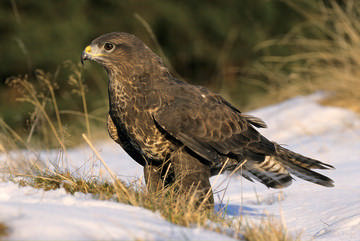
Buzzard © Simon Booth
The Buzzard’s winter distribution differs little from that of the breeding season, except that the requirement for trees is relaxed, allowing the species to use almost every part of the county apart from the most urban areas. The winter habitat codes show, compared to the breeding season, a substantial shift out of woodland (30%) into farmland (59%), with more birds in human sites (4%) and in a range of types of semi-natural grassland and marsh (4%). Adults usually remain on their territories throughout the year. Young birds, becoming independent during their first autumn, have to try to establish themselves between the ranges of surviving pairs. During the early winter, when boundaries are not defended so vigorously, they may be tolerated within a territory, but are driven away as soon as the adults recommence breeding behaviour. Some young birds do wander far during the juvenile dispersal stage, doubtless accounting for their turning up in odd places, including occasionally flying over town centres. Radio-tracking of juveniles has shown that 40% of birds stayed in their natal area during the first winter, and 72% of those that dispersed returned to the vicinity in the following breeding season (Brown & Grice 2005).
In winter, they tend to hunt more from a perch, rather than flying after their prey. Their diet becomes dominated by invertebrates, mainly earthworms, with rabbits when they can get them; but birds become harder to catch and small mammals are scarcer than in the breeding season. An average young rabbit provides about two days’ worth of sustenance for a Buzzard, so they are sought after even when not abundant (Brown 1976). Female Buzzards are about 10% larger than the males, but this does not lead to any significant difference in food choice or hunting technique.
The species’ former status in the county was as mainly a rare visitor during autumn and winter. Their rarity is well illustrated by the ornithological chroniclers. Coward gives the species’ status as ‘a wanderer to Cheshire, more frequently met with in the west than elsewhere’, suggesting that birds seen in Cheshire are from the Welsh population. He lists a few examples, one every few years on average, almost every bird being shot that trapped. Boyd (1946) noted that at least 18 occurrences of the Buzzard in Cheshire were recorded between 1924 and 1936, the majority seen or shot between October and March, with quite a number of them seen in East Cheshire. In his diary for 3 October 1941, Boyd wrote ‘any Buzzards I have seen in Cheshire have been dead ones, trapped or shocked by the ignorant, but I still hope to see a living one in the county’: it is not known if he ever did. Bell (1962), as usual, copied Coward’s comments, saying that ‘most of the published reports come from the Wirral peninsula, although single birds may occur anywhere, especially in the spring and autumn’.
The number of records grew during the 1960s, although most birds were in autumn and the annual Cheshire and Wirral Bird Reports contain few winter reports. In 1968 the County Recorder was apparently so concerned at the number of Buzzard records received (eight) that he urged observers to consider fully the possibility of their being mis-identified Honey Buzzards or Rough-legged Buzzards! Throughout the 1970s and 1980s, even when the species started to breed in Cheshire, the number of wintering birds recorded was still in single figures, and, as shown in the graph, it was only from about 1993/94 onwards that the numbers became uncountable.
It would be a rare day’s birdwatching now without encountering a Buzzard in the county: what a change!
Sponsored by Frank Gleeson

